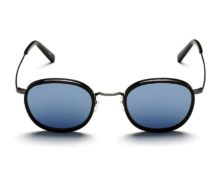Even if you have previously corrected your vision with glasses, switching to new frames or glasses can still be accompanied by discomfort. Moreover, there is no need to panic when unpleasant symptoms appear. Strange or even painful sensations during the first stages of wearing are not considered by medicine as a pathology. This is exactly how the process of getting used to glasses proceeds.
Why do they interfere?
Problems that arise after purchasing a new pair are conventionally divided into 2 groups: physical and ophthalmological. The first category is represented by:
- pressure on the bridge of the nose;
- a feeling of compression arising from the arms;
- skin irritation.
 The first and second moments eliminate themselves after a few days of constant wearing due to the emergence of habit and adaptation of the frame to the anatomical features of the face and skull. To eliminate the third one you will have to change your glasses. The material from which they are made caused an allergic reaction. By the way, it can develop over time.Therefore, if you often have pimples on the wings of your nose or where the bridges meet, or there are signs of other irritation, then you need to rush to the optician.
The first and second moments eliminate themselves after a few days of constant wearing due to the emergence of habit and adaptation of the frame to the anatomical features of the face and skull. To eliminate the third one you will have to change your glasses. The material from which they are made caused an allergic reaction. By the way, it can develop over time.Therefore, if you often have pimples on the wings of your nose or where the bridges meet, or there are signs of other irritation, then you need to rush to the optician.
Important! If something like bedsores form on the wings of the nose, then it is worth changing the frame to a more compact one, and the glass, oddly enough, it will sound, to non-glass. Products made from a special polymer material will suit you.
Ophthalmological problems are not associated with a lack of physical habit. This category of unpleasant manifestations includes changes in the perception of the surrounding reality and failures to focus. Examples of such difficulties:
- a change in the distance to the floor, steps or other surface on which a person is located, and the accompanying problems with understanding one’s position in space and with what efforts need to be made to change this position (example: not being able to correctly determine how much one should raise one’s leg, a man trips on a step);
- making objects smaller or larger (example: some people have to take off their glasses when sewing);
- changing the distance to the surrounding environment (example: a tripping person tries to grab an object, but it turns out that it is located a little further than it seems).
 Some of these phenomena can be attributed to the consequences of getting used to a particular frame and to certain lenses. A similar development of events cannot be avoided when switching from spherical lenses to aspherical ones, when vision drops by more than 0.75 D (accordingly, new glasses will differ from the previous ones by 0.75 D) and when the cylinder axis changes by more than 10 degrees.
Some of these phenomena can be attributed to the consequences of getting used to a particular frame and to certain lenses. A similar development of events cannot be avoided when switching from spherical lenses to aspherical ones, when vision drops by more than 0.75 D (accordingly, new glasses will differ from the previous ones by 0.75 D) and when the cylinder axis changes by more than 10 degrees.
Other unpleasant manifestations talking about incorrectly chosen glasses. For example, for correct selection it is not enough to know visual acuity and the distance between the eyes. The recipe also contains other parameters that are determined during diagnostics.
Checking is necessary and then to exclude the presence of ophthalmic diseases requiring special lenses. Therefore, if you purchased glasses without a prescription or using an old form, no one can guarantee that unpleasant phenomena such as nausea, dizziness and severe changes in the picture will disappear or at least become less pronounced. If the possibility of an incorrect selection is excluded, then all that remains is to be patient and make efforts to develop the habit as quickly as possible.
Are there ways to get used to it?
Unpleasant sensations can be minimized. To do this, follow the following rules and recommendations:
 on the first day, limit the time of use;
on the first day, limit the time of use;- with each subsequent day, increase the wearing time;
- at the very first use, let your eyes get used to the new sensations, just sit motionless in them for a few minutes;
- then complete the tasks that the glasses are designed to help solve (if you are nearsighted, try to look at objects on the street; if you are farsighted, read the text);
- take off your glasses before going up the stairs, but don't hesitate to use the railings;
- if difficulties are associated with the amount of light penetrating through the glass, buy lenses with tinted or reflective coating;
- Do your daily activities while wearing glasses (do this even if your daily tasks start to take more time).
How long will it last?
The process is purely individual. It is impossible to give an exact answer, since the state of health, the correct fit of the frame and the type of lenses used are unknown. Moreover, the second parameter - the location of the center of the lens strictly in front of the pupil - is not always checked even in optics.
Important! Specifics in this matter are excluded, but there is an approximate, rather wide range. It varies from several days to 2 weeks.
How to “defeat” astigmatic glasses?
To shorten the addiction process, you should think about ordering frames made to suit your needs. This behavior is rational if at least 1 item below corresponds to what is indicated in the glasses prescription:
- the spherical component is equal to or greater than ±4.0 D;
- the eyes have different visual acuity or the size of the cylindrical component;
- astigmatic lenses are prescribed for the first time;
- the cylindrical component is equal to or greater than 1.0 D.
If it is not possible to order a unique frame, then when choosing a ready-made frame, rely on the following recommendations:
 go to the optician in the morning;
go to the optician in the morning;- do not order glasses if you are undergoing therapy with potent drugs or are pregnant;
- take with you your old prescription and old glasses (lenses);
- try not to choose frames that are radically different in size and clearance from the version you wore before;
- opt for high refractive index lenses.
In general, you need to be prepared for the fact that the addiction process will take a long time.. This cannot be avoided; this is a feature of astigmatic glasses. Moreover, in their case the principle applies: the higher the degree of astigmatism, the more difficult it is to adapt. The average time it takes to form a habit varies from a few minutes to a month.
Important! For older patients, the process is delayed even more, so they need a gradual transition to a new type of glass: first they take a product with smaller diopters, and then gradually come to the required value.
What not to do?
- do not bend the frame trying to adapt it to your face;
- do not buy glasses according to the old prescription and finished products that do not take into account any of your indicators except for visual acuity (these are usually sold in markets and in dubious shops);
- after the first failures, refuse a new pair for a long time (the first week you need to resort to glasses as often as possible, otherwise the habit will simply have nowhere to come from);
- ignore the increasing severe pain and dizziness.
If the symptoms not only do not disappear over time, but also intensify, then this is a reason to contact a specialist. Perhaps an error was made during the selection or manufacture of glasses.




 1
1





